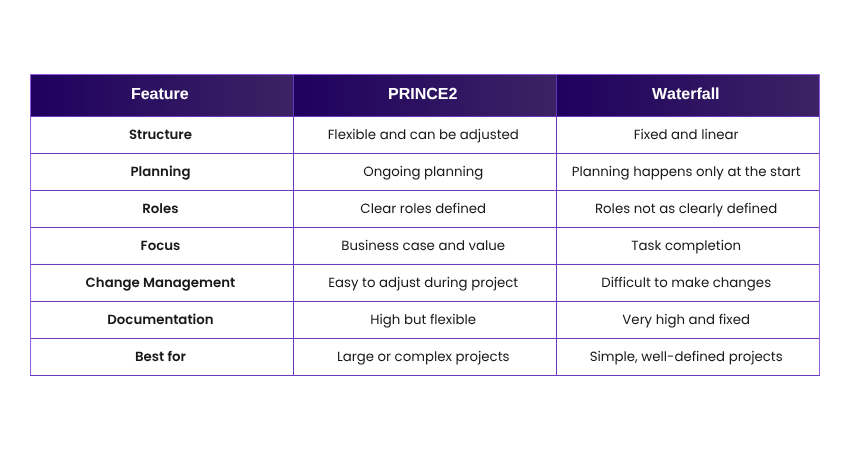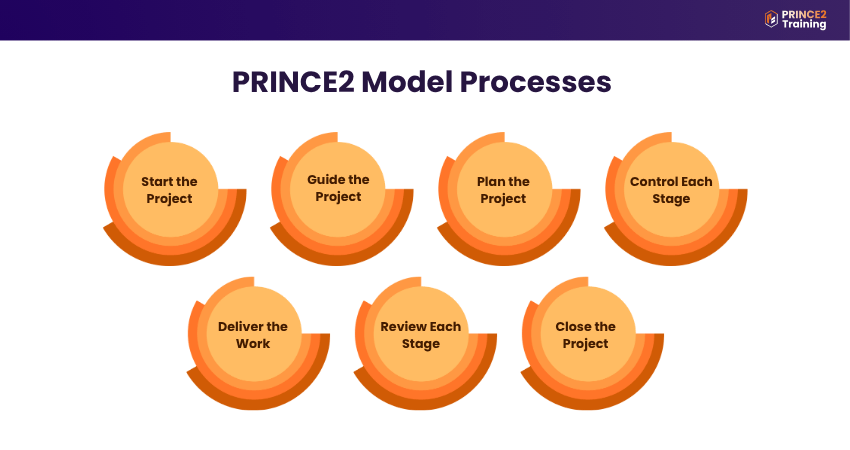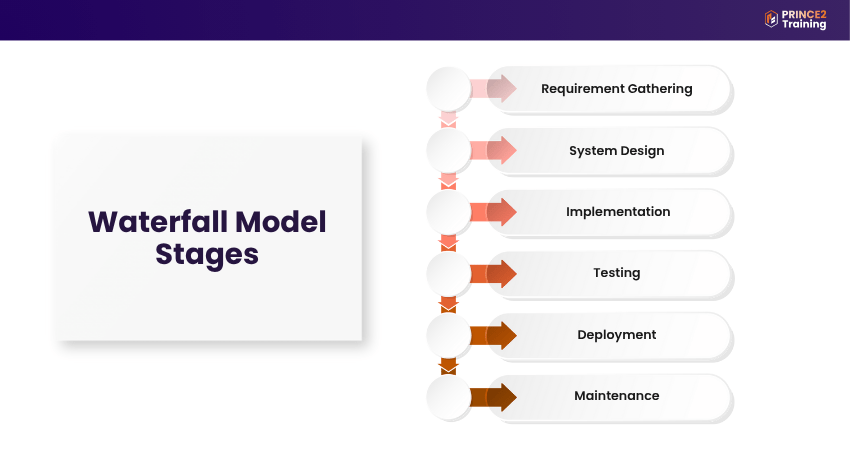Table of Contents

Remember workplace projects? Some organisations prefer to map out every detail from the start - fixed timelines, clear tasks, and no changes along the way. That’s Waterfall. Others rely on regular reviews, team check-ins, and updates based on ongoing progress. That’s PRINCE2. Both approaches get the job done, but the way they work is completely different.
In this blog, we’ll break down PRINCE2 vs Waterfall in simple terms. Whether it’s an IT rollout or a construction project, you’ll discover which method best aligns with your project goals. We’ll explain it clearly and with confidence to help you make the right choice.
Table of Contents
1) What is PRINCE2 Methodology?
2) What is the Waterfall Methodology?
3) Key Difference Between PRINCE2 and Waterfall
4) PRINCE2 Processes in Detail
5) Waterfall Model Stages in Detail
6) Conclusion
What is PRINCE2 Methodology?
PRINCE2, which stands for Projects IN Controlled Environments, is a structured Project Management methodology developed by the UK government. It’s widely used in both public and private sectors to manage projects in an organised and efficient way.
The method breaks down projects into smaller, manageable stages, focusing on planning, monitoring and control. It defines clear roles, responsibilities and processes, offering a roadmap that helps teams keep on track and managers maintain control regardless of the project’s size.
Key Benefits of Using PRINCE2
1) Clear Structure: PRINCE2 gives a step-by-step process to follow, making the project easier to manage.
2) Defined Roles: Everyone knows what they are responsible for, which reduces confusion.
3) Focus on Business Goals: PRINCE2 includes regular reviews to make sure the project remains aligned with business objectives and continues to deliver value.
4) Scalable: PRINCE2 can be adjusted for small or large projects.
5) Better Risk Management: It helps identify and deal with risks early.
6) Widely Recognised: Many organisations trust PRINCE2, and certified professionals are in demand.
What is the Waterfall Methodology?
Waterfall is one of the traditional Project Management methods. It is simple and follows a straight, step-by-step path, like water flowing down a Waterfall. This method is widely used in construction, manufacturing, and traditional software development projects.
In the Waterfall method, each stage of the project is completed before moving to the next. You cannot go back to a previous step once it is finished. This makes planning very important because changes are hard to make later. It works best when the requirements are clear from the start and not likely to change.
Key Benefits of Using Waterfall
1) Simple and Easy to Follow: Each phase is clear and completed before moving on.
2) Well-documented: There is a lot of planning and paperwork, which helps keep everything organised.
3) Good for Fixed Requirements: If the client knows exactly what they want, Waterfall works well.
4) Easy to Measure Progress: You can clearly see which stage the project is in.
5) Best for Smaller Projects: It works well when tasks are straightforward and won’t change.
Understand how to manage risks and ensure project success. Join our PRINCE2® Practitioner Training now!
Key Difference Between PRINCE2 and Waterfall
While both PRINCE2 and Waterfall are traditional Project Management methods, they have many differences in how they are planned and managed. This PRINCE2 vs Waterfall comparison highlights the unique structure, flexibility, and approach each method brings to project delivery.

Structure
PRINCE2 is adaptable and allows changes as the project progresses. Waterfall follows a fixed sequence where each phase must be completed before moving on to the next.
Planning
PRINCE2 involves continuous planning and updates throughout the project lifecycle. Waterfall completes all planning upfront, with little to no change later.
Roles
PRINCE2 clearly defines responsibilities for each team member, improving accountability. In Waterfall, roles are less defined, which may cause overlap or confusion.
Focus
PRINCE2 keeps checking whether the project is still meeting its intended outcomes. Waterfall focuses strictly on delivering tasks as outlined at the beginning.
Change Management
PRINCE2 can accommodate changes more easily during the project. Waterfall makes it difficult to go back or revise earlier stages once completed.
Documentation
PRINCE2 requires good documentation but allows flexibility based on the project's needs. Waterfall relies on extensive documentation that is usually fixed from the beginning.
Best For
PRINCE2 is suitable for large or complex projects that require adaptability. Waterfall works best for small, clearly defined projects where requirements are unlikely to change.
PRINCE2 Processes in Detail
PRINCE2 is based on seven processes that help guide the project:

1) Start the Project: Check if the project is worth starting. Gather basic information and create a brief.
2) Guide the Project: Senior Managers oversee the project and ensure it stays aligned with the business goals.
3) Plan the Project: Create the full project plan, including risks, quality, time and cost.
4) Control Each Stage: Monitor progress in each stage and manage issues.
5) Deliver the Work: Manage Product Delivery: Ensure project outputs are created and delivered according to the plan.
6) Review Each Stage: Review progress and decide whether to continue or adjust the plan.
7) Close the Project: Wrap up the project, confirm completion, and report results.
These steps help keep the project under control from beginning to end.
Fast-track your Project Management career with PRINCE2® Foundation & Practitioner Training now!
Waterfall Model Stages in Detail
The Waterfall method also has clear stages, followed one after the other:

1) Requirement Gathering: Collect all the details about what the project needs to achieve.
2) System Design: Plan how the system or product will work and look.
3) Implementation: Start building the product or system.
4) Testing: Check the system for any bugs or problems.
5) Deployment: Deliver the final product to the client or end-user.
6) Maintenance: Fix any issues that come up after the product is used.
In Waterfall, each stage must be completed before the next one starts. This makes it easy to track progress, but hard to make changes once something is done.
Conclusion
Choosing between PRINCE2 vs Waterfall depends on your project’s size, complexity, and need for flexibility. PRINCE2 offers structure with room for change, while Waterfall follows a clear, fixed path. Understanding their differences helps you choose the right approach, improve delivery and achieve success with confidence, no matter what type of project you are managing.
Understand how to manage time and boost daily productivity. Join our PRINCE2® Foundation Training now!




 Back
Back


 Back to
topics
Back to
topics









